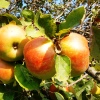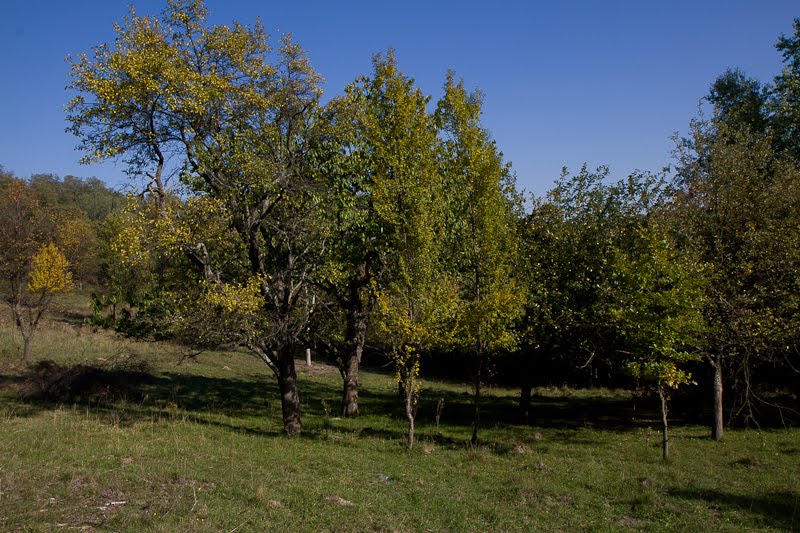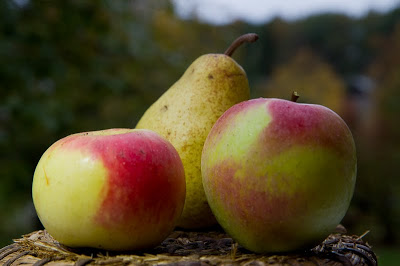 With this short article you will read the first of a series of texts, which week by week throughout one whole year present the important tasks that have to be done in the garden. Besides this we will glance into the tricks of the trade of green home or household techniques as well. The first writing, reflecting on last years autumn, will speak about the planting of fruit trees.
With this short article you will read the first of a series of texts, which week by week throughout one whole year present the important tasks that have to be done in the garden. Besides this we will glance into the tricks of the trade of green home or household techniques as well. The first writing, reflecting on last years autumn, will speak about the planting of fruit trees.
Why are regionally native fruit trees better?
One of my most ardent wishes came true, when I began working in our garden neighbouring Krishna Valley. I consider gardening not merely a useful productive engagement or excellent outdoor and spare-time activity. Although these are not negligible angles of it at all, to me gardening is a challenge to create well functioning living systems. By profession I am a gardener and botanist, vegetation researcher, too. Both fields are related to plants and experience in these fields show that life of living organisms can only be healthy and harmonious, i.e. sustainable if entities of plants, animals live in systems, in a more or less stable cohabitative structure.
Gardening based on organizational perception has become known as permaculture (the perm prefix relates to the permanent, sustainable nature of such cultures). In Hungarian an elaborate and excellent summary of the topic is given in the book of Béla Baji, who is the foremost expert in Hungary on permaculture. (You may read a review on the book with some downloadable parts of it by clicking on the link here.) The fundamental principle of permaculture is that plants and animals in nature live in groups, communities and their life does not merely consist of rivalry to have access to water, light, food and so on, but they protect, give shelter and nurture each other. In a system of permaculture we endeavour to decrease competitiveness and increase the number of advantageous relations. We will speak on this more in our series of articles, but now let us turn to sustainable fruit producing systems.

In traditional fruit orchards numerous fruit trees were planted. This is quite beneficial for plant protection and conservation, furthermore, it provides fruit diversity as well. (Photo: karancs-medves.blogspot.hu)
In our half-hectare large fruit garden I focus on traditional, regionally (Somogy county) native fruit trees.
Long-standing trees are much more resistant than mass-produced trees nowadays. Oftentimes they are more resistant to diseases as well, but if they are not, their regenerating capability is outstanding. This is a highly important factor in organic gardening. If long-standing, old-timer fruit trees are worm-eaten or affected by fungal infection in a year, there is no trace of it at all the following one. Usually they are more drought resistant or even moisture resistant, too.

Two famous, traditional apple produces. The Batul (left) and the Easter Rosemary (right) are picked in autumn and can be stored for a long time, even until springtime. (Photo: karancs-medves.blogspot.hu)
In our garden, following the suggestion of Béla Baji, I plant saplings in a scattered way about 5 to 10 meters from each other. I also plant them sporadically and mixedly. As plant protection will be limited, therefore, it is essential not to make a monoculture out of certain trees. It is better to plant plum and cherry trees around small groups of pears. Most of the fruits are anemophilous, which means they like to use pollen from other types of fruit trees of the same kind and that is the reason why it is advisable to plant more type of trees of the same species.
The best time for planting is in autumn after falling of the leaves in frostless weather. Naturally, one can plant trees in springtime before frondescence, however, it is a less successful period. It is advisable to dig the holes a few weeks beforehand and the diameter of the hole should be three-four times bigger than the root of the tree. In this way, we provide optimal, friable, airy soil for the sapling with appropriate rooting circumstances. Making a good start is inevitable in a fruit trees life. The depth of a hole should be the same as it was prior to taking out the sapling from the soil. Therefore, the sapling should be planted in a similarly deep hole as it was before. If the tree is in a ball of earth, then this is obvious. If the root is bare then we have to examine the collar of the sapling and it will be apparent how deeply was the tree planted in the nursery.
András Kun
